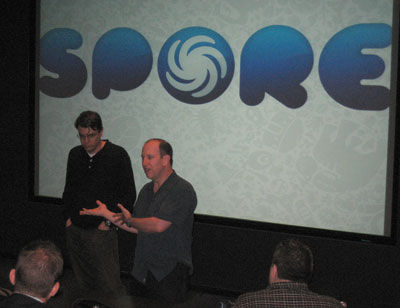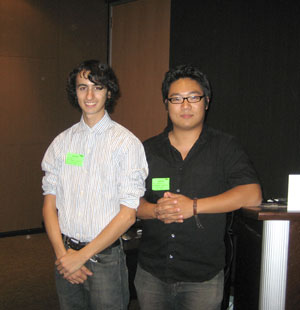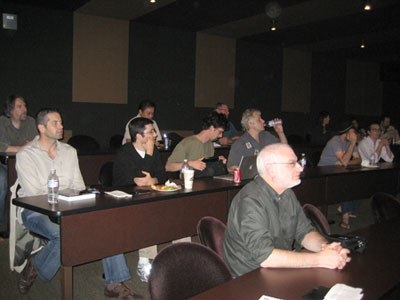October Game Deconstruction Group Examines Spore
11/1/2008

The Game Deconstruction Group examines the most critically and commercially acclaimed video games in order to answer the question: what makes great games great? At the group’s most recent gathering hosted by Electronic Arts Los Angeles on October 30th, game makers gathered to discuss Will Wright's ambitious and all-encompassing sim-everything game Spore. The attendees, consisting of designers, artists, programmers, and producers from game companies across Southern California, got to bottom of the issue during an evening of food, laughter, and good-natured debate.
 USC Game Design students Brian Abrams and Al Yang led the evening's presentation with a generous helping of gameplay demonstrations and thoughtful analysis. The presentation covered everything from the game's emphasis on creativity and user customization, to its various gameplay modes, to its use of cutting-edge procedural animation technology to animate the literally endless number of anatomical possibilities presented by the custom creature creator, to the existence of a special encyclopedia created specifically to help players navigate of the game's sheer number of options.
USC Game Design students Brian Abrams and Al Yang led the evening's presentation with a generous helping of gameplay demonstrations and thoughtful analysis. The presentation covered everything from the game's emphasis on creativity and user customization, to its various gameplay modes, to its use of cutting-edge procedural animation technology to animate the literally endless number of anatomical possibilities presented by the custom creature creator, to the existence of a special encyclopedia created specifically to help players navigate of the game's sheer number of options.
One of the most thought-provoking issues brought up by the attendees was the question of whether a game can be "too big," especially when one considers its target audience. GDG attendees discussed the obstacles of designing and directing an interactive life-simulator beginning with eukaryotic organisms and concluding with intergalactic travel, and how the size of such a game would influence a design philosophy intended to welcome casual gamers with simplicity rather than alienate them with complexity. The discussion also covered the massive popularity of the game's pre-release "Creature Creator" toolset, and how it helped introduce casual and core gamers alike to the vast universe created by Will Wright and the hard-working team at Maxis Software.
The deconstructors agreed that the achievements of Spore have pushed interactive software into a new realm by incorporating numerous gameplay elements into a single interactive title, and by finding an admirable and effective sweet spot between allowing gamers to express themselves creatively and designing a solid game engine framework.
The Academy once again extends its thanks to the USC game design students for their informative and detailed presentations, and to the attendees for their insights, enthusiasm, and participation.
A copy of the students' presentations is available upon request. To request a copy of the presentations, or to be added to the Game Deconstruction Group mailing list, please contact Terrence Myers.
